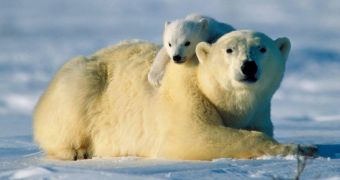American multinational corporation ExxonMobil and Russian company Rosneft, both of which are very much interested in exploiting whatever oil reserves they can get their hands on, have recently entered a partnership.
Together, they wish to go looking for oil in the Kara Sea, a part of the Arctic Ocean located north of Siberia. In fact, ExxonMobil and Rosneft hope that exploratory operations in this region will debut sometime this coming summer.
Since drilling in the Arctic is no walk in the park, what with harsh environmental conditions and greenheads organizing protests every other day, the companies have set up an Arctic Research and Design Center for Offshore Developments.
According to Rosneft, specialists employed by this Center are supposed to solve “all the tasks the company will face when developing shelf deposits.”
More precisely, “It [the Center] will gather global and Russian expertise, develop key competences needed to develop shelf deposits and create new underwater production technologies, including developing ice-class drilling platforms, ships and rigs and underwater systems for oil preparation and shipment.”
Otherwise put, the Arctic Research and Design Center for Offshore Developments will provide ExxonMobil and Rosneft with all the tools and information it might need when setting out to explore and exploit Kara Sea.
Ironically enough, Daily Mail tells us that the two companies' research and development center is now looking for people who are ready and willing to spend some time counting polar bears living around Kara Sea.
The polar bears targeted by this ExxonMobil and Rosneft initiative belong to some 20 – 25 different groups, the same source details.
Apart from counting them, folks hired by the Arctic Research and Design Center for Offshore Developments would have to fit up to 20 females with electronic monitoring collars.
Besides, blood samples would have to be collected and sent to laboratories for analysis, information made available to the public says.
Since the region where ExxonMobil and Rosneft want to go looking for oil is listed as a protected site for this vulnerable species, one might assume that the two companies want to use information collected in this manner to try and minimize the environmental impact of their planned operations.
Still, there are many who claim that the companies are merely trying to trick ordinary folks into thinking that they are interested in whatever biodiversity the Arctic presently accommodates for and in means to protect it.
“In the Kara Sea the blocks that they will be drilling impinge on a supposedly protected Russian national park, an area that's supposed to be sacrosanct,” Ben Ayliffe with Greenpeace said in a statement.
“In other regions they hope to drill later, one of the places – Wrangel Island – is actually a Unesco World Heritage site where polar bears breed.”
“So it's ironic that they are advertising for polar bear spotters when they are actually planning to drill in the nursery for polar bears in the Arctic,” the environmentalist added.
Just for the record, it must be said that ExxonMobil and Rosneft are ready and willing to pay their professional polar bear spotters up to ₤400,000 (about €477,620 / $660,200).
Those who sign up for one such job must be brave and resilient, and well able to handle temperatures of minus 46 degrees Celsius (minus 114.8 degrees Fahrenheit).

 14 DAY TRIAL //
14 DAY TRIAL //